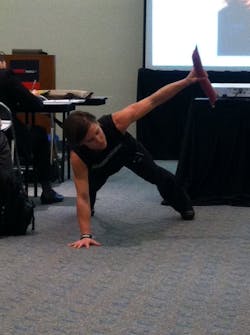Firefighter Fitness Requires More than Pumping Iron
On any given day in firehouses across the nation, you’ll likely see firefighters pumping iron in gyms.
But, are those exercises really gearing them up for the various tasks associated with firefighting?
Most likely not, Sarah Apgar, a certified trainer and tri-athlete told students at Firehouse World.
The demands of firefighting require specialized training as certain parts of the body are impacted.
Proper exercising is known to reduce firefighter injuries. Apgar said she’s astounded at the NFPA report that showed 65,880 firefighters were injured on duty in 2013.
She has created specific circuits that coincide with the jobs associated with firefighting such as ventilation techniques, hose handling, ladder and gear operations and search.
While all are important, she emphasized that it’s vital that firefighters have the cardio and pulmonary effort required to do the job.
“When the alarm sounds, you’re expected to go from 0 to 60 in minutes,” she said, adding that it’s a strain on the heart if not prepared.
Heart attacks have been the leading cause of death of firefighters for the past decade, she told the group.
“It’s important you get a good cardio workout. Get the blood pumping,” she said.
When throwing ladders, glutes get a workout as stability is essential.
She demonstrated various workout exercises while handling hoses and tools, and students were recruited to help.
Using a pike pole to pull a ceiling can cause severe injury if the firefighter isn’t prepared for the repetitious work.
Forcible entry also places a strain on shoulders and forearms as the firefighter grips the tool.
And, crawling through a structure doing sweeping motions during a search requires focus on other parts of the body.
Apgar, an Army veteran and volunteer firefighter, has been working with FDNY academy instructors to teach rookies the skills.
“Fireground injuries are preventable.”
Apgar said she hopes future fitness competitions involving firefighters will incorporate some of the skills actually used on the job. “It’s not just about weights.”
Low motion, weight load and cardio bursts must be kept in mind when firefighters train.
The only way to reduce the number of firefighter deaths and injuries is to train for the job – which, Apgar said, is more than pumping iron.
Full Coverage of Firehouse World:
- Photos: Hands-on Training
- Science Needs to Be Incorporated in Modern Firefighting
- Competent Command Essential at Incidents
- Innovative Apparatus on The Show Floor
- Firefighters Face New Challenges Daily
- Eisner Remember, Change Discussed at Firehouse World Opening
- Photos: Day 2 of Firehouse World
- Officers Reminded to Spend Time with Rookies
- A West Coast Versus East Coast Debate
- Photos: Day 3 of Firehouse World
- Fire Service Tradition Is Challenged by Progress
- Hash Oil Labs Create Danger
- Managing Social Media to Protect the Fire Service's Image
